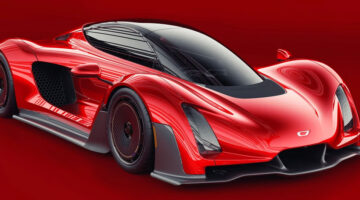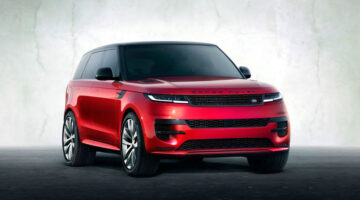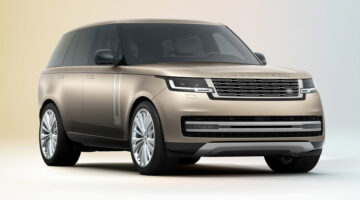Land Rover’s all-new mid-size SUV – the Range Rover Velar – gets set to take on the Porsche Macan
Sitting between the Evoque and the Range Rover Sport, the Velar is Land Rover’s luxury offering to customers that don’t need an SUV as big as the Sport yet find the Evoque too small. It’s also a principal rival to Porsche’s Macan and Jaguar’s F-PACE, and will be priced accordingly, starting at $54,000.
The name is Latin for ‘veil’ or ‘hide’ and harks back to the name of a prototype version of the original Range Rover. Despite targeting the smaller Porsche SUV, the Velar is on the large size for its segment, and is in fact closer in length to a Cayenne or a BMW X6 at 4.9m. Looks-wise, the Velar bears an obvious relationship to its Range Rover siblings but evolves the style with some interesting new touches, like door handles that retract flush with the bodywork when the car is moving. At the front, super slim LED headlights are available with adaptive matrix function, which maintain full beam while placing shadows over oncoming cars to avoid dazzling drivers.
The interior has a minimalistic but spacious feel, and key features include a touchscreen that sits flush with the dashboard when the car is not in use, and rises up when the engine starts to show navigation and entertainment information. A gloss-black touch-sensitive panel underneath houses a second touchscreen that shows air conditioning and car setup information. As well as touch controls, two large dials are used to navigate through information, which change function depending on what screen is active. A 60GB hard drive stores video or audio content. In front of the driver sits another digital display, which displays driving information and is configurable in four different modes. The steering wheel features touch-sensitive controls that allow scrolling, much like swiping on a smartphone.
As well as the obligatory leather upholstery, the Velar will come with the option of a Danish wool blend fabric called Kvadrat, mixed with faux-suede microfibre inserts made from recycled plastic bottles. Used in luxury furniture, Kvadrat reflects Land Rover’s desire to offer a high-end alternative to leather in the hope that cloth won’t always be seen as an inferior specification. Part of the reason for this move is a rise in veganism and animal welfare concerns around the world, and it’s surely no coincidence that Land Rover’s parent company JLR is owned by Indian firm Tata, a country where large sections of the population will not use products from cows.
There are plenty of connectivity options in the Velar, including four USB charging points and a wifi hotspot for up to eight devices, using 4G connectivity. A Meridian sound system is available, as is a head-up display.
We had a sneak preview of the Velar ahead of its launch at the Geneva Motor Show, and saw two versions. The HSE is a more entry-level model but still very generously styled and equipped, while the top-end R-Dynamic has more aggressive bodywork and some extra styling features, including bonnet vents finished in burnished copper. First Edition models will be available for early adopters.
Gerry McGovern, Land Rover’s chief design officer, said the Velar is a reflection of the company’s belief that there’s plenty of potential for expansion into new areas, especially as SUVs become more popular around the world.
“As we grow, we need to make sure we maintain our uniqueness,” he said. “We are making a shift from what has been, in the past, a very specialist brand to a more universally appealing brand. Once we become the same as anybody else, it’s over as far as I’m concerned.
“This is a white space vehicle, it doesn’t exist for us. There are other vehicles on the market of a similar size, but there isn’t anything quite like this. It’s modern, it’s elegant; it’s still understated as a Range Rover but has very dramatic presence. It’s the most car-like of our vehicles in terms of its overall height, but it’s incredibly light and refined.”
The Velar wouldn’t be a proper Range Rover without some serious dynamic capability both on and off-road, and so its underpinnings have been crafted from 80 percent aluminium to minimise weight, with steel and magnesium elements to stiffen the monocoque. With a drag coefficient of just 0.32, it’s the slipperiest Range Rover ever made, which should help with fuel efficiency at speed.
All-wheel drive is standard, with double wishbone front suspension and an integral link setup at the back. Intelligent Driveline Dynamics sends torque to whatever axle needs it the most, while the rear axle sports an electronically controlled rear differential to find the maximum grip from either back wheel. On road, a system called Adaptive Dynamics Technology monitors the road surface as well as inputs from the driver to automatically adjust the damping setting to give either a cosseting ride or a tighter set up on tighter roads or during more ‘enthusiastic’ driving.
For off-road use, key features include 650mm of wading capability and a wade-sensing system that displays the current depth of water on the internal screen. Opt for a Velar with air suspension and you’ll get more than 250mm of ground clearance, and the ability to lower the car for easier entry or, for example, to hitch a trailer.
Globally, six powertrains will be available. Three are diesels that we’re unlikely to see in the Middle East, but the three petrol engines should keep us happy. They start with a four-cylinder, 2-litre Ingenium unit with 247bhp and a 296bhp version following later in the year. For those with a hankering for more power, a supercharged 3-litre V6 with 375bhp will take the battle to the slightly more powerful Porsche Macan Turbo. The Velar goes on sale later this year, with prices starting at $54,000 for the 2-litre version, and $70,000 for the V6.



